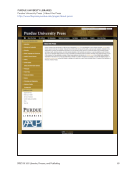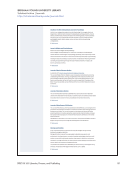56 Survey Results: Survey Questions and Responses
-how can we market
-editorial services provided
-best practices for author agreements and journal policies
-understanding of CC licenses
Assert your role as publisher. This is important in order to act authoritatively for the benefit of your
publishing partners and to steer your publishing program in a way that’s aligned with the library’s
mission. Manage expectations by knowing how you are going to interact with your publishing partners
and defining this carefully up front through formal service agreements, house policies, and best
practices. Forming partnerships and plugging into national and international advocacy groups will help
a small operation to keep up (and influence!) policy and technology developments for library publishing
(OASPA, PKP, LPC).
By merging the press and the scholarly publishing office we are able to meet author needs for a
continuum of publishing formats and services. It is important to keep branding separate for works that
are heavily peer-reviewed and have the benefit of acquisitions editorial investment from those that are
produced in a more lightweight workflow.
Contracting via a MOU to assure uniform understanding of who is doing/responsible for what.
Create an MOU describing exactly which services are provided by the library and which fall upon the
university entity desiring the publishing services. Since the library’s reputation has the potential to be
affected by the quality of what it publishes, provide resources on best practices, even if enforcement of
them falls to the other responsible entity. Do not bite off more than you can chew. If you’re not staffed or
trained to branch out into another realm of publishing, don’t agree to do it!
Define what is meant by press publishing and library-led publishing and be clear on scope. Don’t
try to re-invent wheel. Identify where you can leverage expertise and collaborate. Rely on expertise
in libraries, university presses, Library Publishing Coalition, etc. Share your stories and ask others
for theirs. Takes considerable expertise and time to implement at programmatic level, with solid
investment required.
Decisions on services offered is essential to moving past ad hoc phase. Should be integrated into broader
library digital plan (digital preservation, OA, repository, etc.), and align with broader institutional
strategic directions.
Develop and adopt policies before embarking on publishing activities. Find partners, especially on
campus. Be patient. A program of this magnitude can take several years to develop.
Expectations and realities of business model difficult for library management to understand, particularly
costs vs. profits. Understanding of university press mission re: publishing university faculty, peer review
is a lengthy process. Schedules and length of time from concept to published book. The library runs on
efficiencies, data, and automation vs. the custom and individualized steps in book publishing.
Have enough staff upfront to launch publishing activities: This means having not only a Scholarly
Communication Librarian, but at least one fully dedicated technical staffer to mount and maintain the
publishing platforms. Have room to fail and flexibility for experimentation with different platforms
and workflows—it will take time to get publishing activities off the ground. Build strategic partnerships
across campus with business services and legal counsel in order to develop and implement effective legal
agreements for the library publishing unit.
If at all possible, do not charge people for the provision of publishing services—many people can execute
basic publishing on their own for little or no money and they won’t be gung-ho to start paying for it.
Because of lesson 1, have a clear sense of what makes library publishing services worth the money it
might cost to utilize them, and make sure there is a team of people to spread that message as they try to
-how can we market
-editorial services provided
-best practices for author agreements and journal policies
-understanding of CC licenses
Assert your role as publisher. This is important in order to act authoritatively for the benefit of your
publishing partners and to steer your publishing program in a way that’s aligned with the library’s
mission. Manage expectations by knowing how you are going to interact with your publishing partners
and defining this carefully up front through formal service agreements, house policies, and best
practices. Forming partnerships and plugging into national and international advocacy groups will help
a small operation to keep up (and influence!) policy and technology developments for library publishing
(OASPA, PKP, LPC).
By merging the press and the scholarly publishing office we are able to meet author needs for a
continuum of publishing formats and services. It is important to keep branding separate for works that
are heavily peer-reviewed and have the benefit of acquisitions editorial investment from those that are
produced in a more lightweight workflow.
Contracting via a MOU to assure uniform understanding of who is doing/responsible for what.
Create an MOU describing exactly which services are provided by the library and which fall upon the
university entity desiring the publishing services. Since the library’s reputation has the potential to be
affected by the quality of what it publishes, provide resources on best practices, even if enforcement of
them falls to the other responsible entity. Do not bite off more than you can chew. If you’re not staffed or
trained to branch out into another realm of publishing, don’t agree to do it!
Define what is meant by press publishing and library-led publishing and be clear on scope. Don’t
try to re-invent wheel. Identify where you can leverage expertise and collaborate. Rely on expertise
in libraries, university presses, Library Publishing Coalition, etc. Share your stories and ask others
for theirs. Takes considerable expertise and time to implement at programmatic level, with solid
investment required.
Decisions on services offered is essential to moving past ad hoc phase. Should be integrated into broader
library digital plan (digital preservation, OA, repository, etc.), and align with broader institutional
strategic directions.
Develop and adopt policies before embarking on publishing activities. Find partners, especially on
campus. Be patient. A program of this magnitude can take several years to develop.
Expectations and realities of business model difficult for library management to understand, particularly
costs vs. profits. Understanding of university press mission re: publishing university faculty, peer review
is a lengthy process. Schedules and length of time from concept to published book. The library runs on
efficiencies, data, and automation vs. the custom and individualized steps in book publishing.
Have enough staff upfront to launch publishing activities: This means having not only a Scholarly
Communication Librarian, but at least one fully dedicated technical staffer to mount and maintain the
publishing platforms. Have room to fail and flexibility for experimentation with different platforms
and workflows—it will take time to get publishing activities off the ground. Build strategic partnerships
across campus with business services and legal counsel in order to develop and implement effective legal
agreements for the library publishing unit.
If at all possible, do not charge people for the provision of publishing services—many people can execute
basic publishing on their own for little or no money and they won’t be gung-ho to start paying for it.
Because of lesson 1, have a clear sense of what makes library publishing services worth the money it
might cost to utilize them, and make sure there is a team of people to spread that message as they try to



















































































































































































